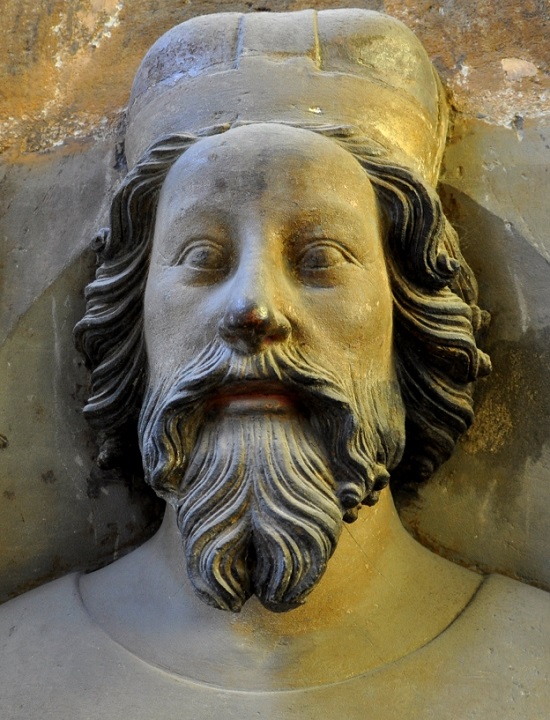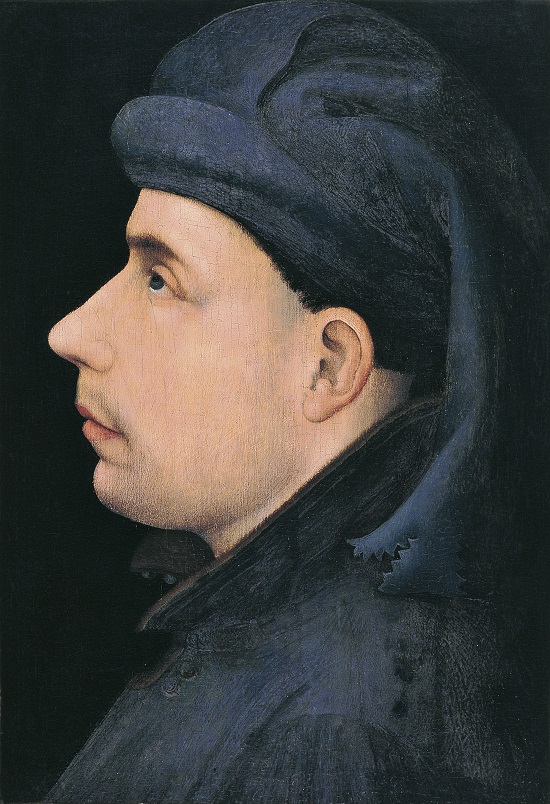By Jan Boukal
„I couldn’t find more joy in the service; it means everything to me. And as I give it all I have, I hope I deserve the same. I want to walk the path safe from treason and to reach the happy gates; that’s why I put my faith to these words. My Lady, as I’m waving you farewell, I leave my body with my devoted heart here for you; take it for good.”

Bust of Wenceslas of Luxembourg on the triforium of St. Vitus Cathedral (author: Packare)
These words were written by the Luxembourgian and Brabant duke Wenceslas of Luxembourg, also known as Wenceslas of Bohemia. In the Czech environment, however, he is relatively unknown. He was born on February 23, 1337, in Prague as the son of John of Luxembourg and his second wife Beatrix of Bourbon, and therefore was the half-brother of Charles IV. By choosing a Czech name for her son, the French mother tried to help his position in the Czech environment. Even before Wenceslas was born, the wedding contracts of his parents ensured he would become the monarch of Luxembourg one day. Old king John thought he could marry his son off to the daughter of the Roman king Louis of Bavaria, yet this plan failed as the relationships to Louis changed after some time. After John’s death at the battle of Crecy, Wenceslas’s mother Beatrix started planning his wedding. She chose a new bride for him – Joanna of Brabant, 15 years his senior, daughter of Duke John III. She was a widow of William Count of Holland, and the heiress of the Brabant lands. Joanna and Wenceslas got engaged in 1347, but they didn’t marry until 1352. Their marriage was quite harmonious but childless; Wenceslas was known to father several bastards.
Since mid-1350s, Wenceslas lived mostly in Brussels. His court was famous for its tournaments, feasts and balls, with big emphasis on music and poetry. Frequent guests included poets Eustache Deschamps and Guillaume de Machaut, or the chronicler Jean Froissart. The latter wrote that Wenceslas was “amiable, gallant and chivalrous, loved tournaments, dancing and good laughter; his generous nature attracted many knights and other noble people.” Froissart even began, on Wenceslas’s order, to write a rhymed novel Méliador, inspired by popular novels on King Arthur. Wenceslas himself was an active author; 79 of his French-written poems have preserved to this day. These poems were translated to Czech by Gustav Francl.

Wenceslas’s portrait from the early 15th century
Charles IV gave his brother’s Luxembourg County the status of a duchy, with many other benefits. Wenceslas obtained the right to ride on the emperor’s left side on campaigns against rebels, was allowed to carry an imperial sword, and was appointed the arch-waiter, arch-equerry, and later even the general vicar for the western part of the Holy Roman Empire. During his life, he was forced to campaign several times against his neighbors and marauding knights, but he wasn’t always successful in this matter.
In his last years, Wenceslas focused mainly on diplomatic activities in the Empire and in France, aimed at solving the Papal Schism that was most disturbing for the Luxembourgian duke. At that time, he was suddenly smitten by a serious skin disease. Shortly before his death, he’s said to call his court members, showed them his maimed body, and said: “Look at us well, at the body of a noble origin, from the blood of kings and emperors, the body that used to be so beautiful and so firm, and now is covered in leprosy that makes it pale, stinking and disgusting to look. So God made it, to prove my pride and humiliate me. Use this lesson and my example to learn to give up your arrogance, and remove pride from your souls.” Duke Wenceslas died on December 8, 1383, at the age of 46, and he was buried in Orval monastery in Luxembourg (his tomb can still be visited in the ruins of the monastery). His heir in Luxembourg was his nephew Wenceslas IV; in Brabant, his widow Joanna ruled until 1406, and then she appointed her grandnephew Anthony as heir. In his days, duke Wenceslas was one of the most important lords and art sponsors in Western Europe. However, in his homeland country of Bohemia he’s only remembered by the bust in the triforium of St. Vitus’s Cathedral.
Bibliography:
BEJBLÍK, Alois. Václav, vévoda lucemburský a brabantský. In: LUCEMBURSKÝ, Václav. Netoužím po ráji. Praha: Argo, 2005, s. 113–124.
ČECHURA, Jaroslav – ŽŮREK, Václav. Lucemburkové: životopisná encyklopedie. České Budějovice: Veduta, 2012.
FANTYSOVÁ-MATĚJKOVÁ, Jana. Václav Lucemburský. In: ŠMAHEL, František – BOBKOVÁ, Lenka. Lucemburkové: česká koruna uprostřed Evropy. Praha: NLN, 2012, s. 159–165.
FANTYSOVÁ-MATĚJKOVÁ, Jana. Wenceslas de Bohême: un prince au carrefour de l'Europe. Paris: PUPS, 2013.